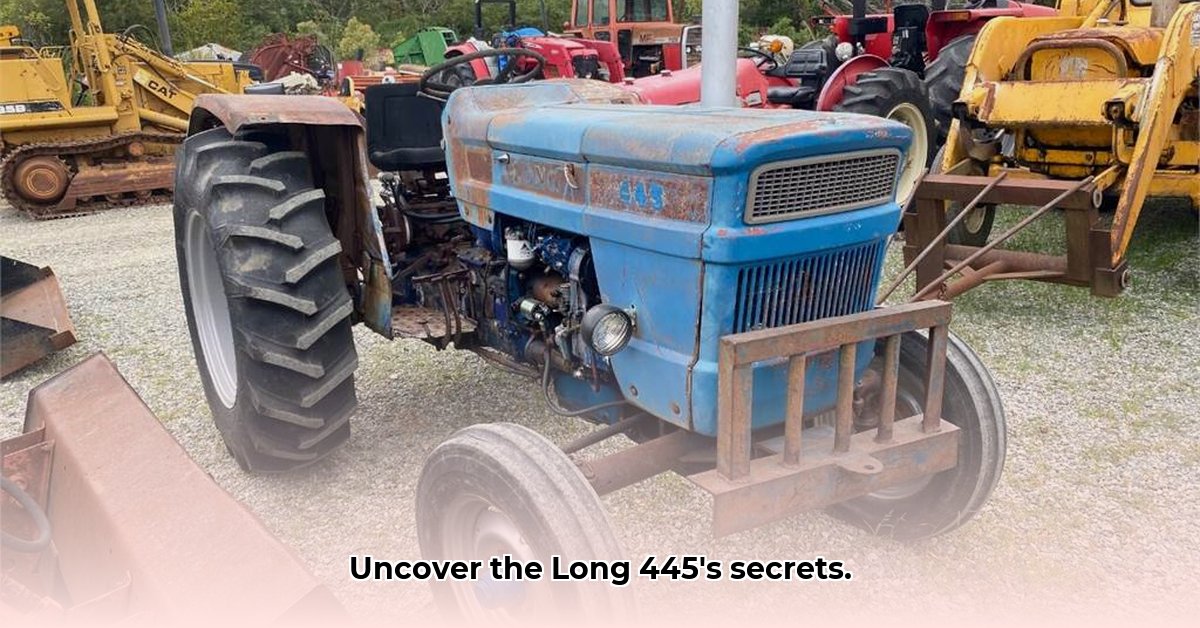
The Long 445 tractor, a robust piece of Romanian agricultural engineering from the 1970s, offers a fascinating blend of history, mechanics, and restoration challenges. This guide delves into its history, technical specifications, operational characteristics, and the intricacies of restoration, catering to collectors, small-scale farmers, and history enthusiasts alike. Whether you're seeking to understand its place in agricultural history or are ready to tackle a restoration project, this comprehensive guide will serve as your essential resource. For more information on similar tractors, check out this related resource.
A Romanian Workhorse: The History of the Long 445
The Long 445 emerged from Romania's agricultural machinery industry during the 1970s, a period of significant agricultural development in the country. While precise production years remain debated (sources suggest a range from 1972 to 1976), its design reflects the era's focus on practicality and durability. Built for the demands of Eastern European farming, the Long 445 earned a reputation for its ruggedness and reliability, a testament to its construction. It wasn't flashy, but it got the job done. Its enduring legacy is palpable in the memories of many Romanian farmers who worked alongside it.
Technical Specifications: Unveiling the Mechanics
The Long 445’s core is an Uzina 2.3L three-cylinder diesel engine, delivering approximately 45 horsepower (though variations exist due to potential testing differences or slight engine model variations). The transmission is a 6-speed manual (partially synchronized), complemented by nine creeper gears. Both two-wheel-drive and four-wheel-drive (445DT) versions were available. While precise dimensions and PTO (Power Take-Off) power require further research due to inconsistent data across sources, its robust construction is evident. Finding your specific tractor's manual will yield the most accurate specifications. Don't overlook this crucial step!
| Specification | Value (Source Discrepancies Noted) | Notes |
|---|---|---|
| Engine | Uzina 2.3L 3-cylinder diesel | Power output may vary slightly; always consult your tractor's manual. |
| Horsepower | ~45 hp | Variations likely due to testing methods or engine model year. |
| Transmission | 6-speed partially synchronized, 9-speed creeper | Offers exceptional versatility for various tasks. |
| Drive | 2WD & 4WD (445DT) | Select the version best suited to your needs. |
| Fuel Tank Capacity | [Insert Verified Capacity] | Crucial for planning work cycles. |
| Dimensions | [Insert Verified Dimensions] | Essential for transport and storage planning. |
| PTO Power | [Insert Verified PTO Power] | Check your specific tractor's manual for accuracy. |
Operational Characteristics: A Hands-On Perspective
Operating a Long 445 is a distinct experience compared to modern tractors. The absence of power steering requires physical effort for maneuvering, especially in tight spaces. However, the open operator station offers excellent all-around visibility – a significant advantage. The tractor's versatility shone in diverse applications, from plowing and tilling to hauling. Understanding its limitations, primarily its slower speed and lack of modern features, is key to utilizing its capabilities effectively. Has anyone ever tried using it for something unexpected? Perhaps an interesting anecdotal story could emerge.
Maintenance & Repair: Ensuring Longevity
Maintaining your Long 445 requires diligence. Regular fluid changes (engine oil, transmission oil, hydraulic fluid) and filter replacements are essential. Consistent lubrication of moving parts is critical for preventing wear. Common failure points include hydraulic leaks, worn engine components, and fuel system problems. The active online community provides an invaluable resource for sourcing original or aftermarket parts; however, rigorous quality checks are crucial before installation.
Restoration Guide: A Step-by-Step Approach
Restoring a Long 445 is a substantial undertaking requiring patience and mechanical aptitude. Follow these steps for a successful restoration:
- Assessment: Thoroughly document the tractor's condition with detailed notes and photographs.
- Disassembly: Carefully disassemble the tractor, meticulously labeling and storing each component.
- Cleaning: Thoroughly clean each part, preserving any markings for later reference.
- Repair/Replacement: Repair damaged components whenever feasible; replace only when necessary, sourcing reliable parts.
- Reassembly: Reassemble the tractor, using your documentation as a guide.
- Testing: Thoroughly test all systems before declaring completion.
Hydraulic System Troubleshooting
The hydraulic system often presents significant challenges during restoration. Low power steering pressure or three-point hitch malfunctions often signal pump issues, including incorrect pump installation or worn components. Troubleshooting steps include:
- Verify correct pump model and rotation (consult the factory manual).
- Conduct thorough hydraulic pressure testing.
- Replace faulty seals, hoses, or filters.
- Carefully adjust linkage if needed. (Always prioritize safety; work only with the tractor shut off and hydraulic pressure relieved).
Conclusion: The Enduring Appeal of the Long 445
The Long 445 may lack the technological advancements of modern tractors, but its simplicity, strength, and dedicated online community create a unique appeal. For collectors, its historical significance is undeniable. For small-scale farmers, it can still prove useful for specific tasks. Understanding its strengths and limitations is key to appreciating this remarkable machine and its lasting legacy in Romanian agricultural history. Are there any other unique aspects of the Long 445's story that you uncovered during your research?